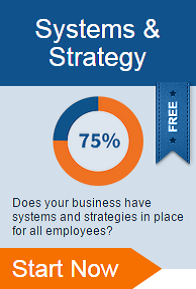Document processes & procedures – so it won’t matter when Joe doesn’t turn up for work
June 25, 2020
“Sorry! We can’t help you! Joe didn’t turn up for work today and we don’t know how to do his job.”
Imagine what your customer would be thinking if this was your response!
Unfortunately, it’s a far too common story for small businesses everywhere. Failure to document processes and procedures means that when Joe doesn’t turn up for work, business grinds to a halt because nobody else understands what Joe does – let alone how he does it or the tools he uses.
When processes and procedures aren’t documented…
Joe may have given everyone advance notice that he wouldn’t be turning up because he was going on holiday.
Perhaps this caused a last minute scramble to find out what needs to be done while he’s away. But, despite Joe’s best efforts in explaining to someone else what he does, it’s almost guaranteed that he will gloss over or forget some details.
He won’t have time to properly train the unlucky person who has to fill in for him on top of doing their own busy job. And he won’t plan for those new issues that will crop up while he’s away.
It’s hard enough when there is advance warning and Joe can give some guidance. But what happens when there is no advance warning?
What if Joe was sick? Too sick to answer his phone, email, messenger, or worse?
Most likely, the customer’s issue won’t be handled correctly, service won’t meet customer expectations, errors will be made, or the customer will simply be left without any response at all.
How much is a lost customer worth to your business?
Even if you don’t lose the customer, how much time is wasted by other employees learning how to do Joe’s job (badly) on the fly? And how much of their own work do they not get done while they are covering for Joe?
All this due to a failure to adequately document processes and procedures.
Are you Joe?
What if you, the business owner, are Joe? This could be why you haven’t had a holiday in over four years!
How much of your business success depends upon you being there every day? What proportion of the day-to-day decisions are made by you and you alone? How many actions and processes depend upon your daily input?
I’m guessing way too much.
If we take Joe, the business owner, out of the business, does the business survive? Many would not.
How to change this in under five minutes: start to document your processes & procedures
- For every question that employees need to ask you, write a simple how we do it here as an answer.
- This collection of answers very quickly becomes a “set of procedures.”
- Upload these policies and procedures into a central location that is accessible by all team members.
- Use a tool that is easily searchable, has version control, and prompts you to review whether how we do it here three or six months ago still applies.
- Write policies and procedures for every aspect of your business.
The collection of answers to how we do it here is a great way to start documenting your processes (the “how” of your business).
This won’t necessarily help with creating a collection of standard policies that support why you do what you do, or why what you do helps the business meet its obligations for compliance, quality or service delivery, according to the standards and expectations you have set out.
For that you may need some assistance…
The benefits of developing your policies & procedures
It’s best to use an established tool to streamline the process of documenting policies and procedures. This will not only save time, but many tools come with a template library to help you get started.
For a busy business owner, this is invaluable, as writing out policies from scratch is no fun and your efforts are unlikely to be totally complete, understandable and effective.
Most SMEs do not have a clear set of policies and procedures that cover all of the major areas of the business.
By developing, documenting, and implementing these policies and procedures adequately, your business can benefit from:
- Improved productivity
- Improved quality
- Improved customer satisfaction
- Increased profit and revenue
- Reduced risk of legal liability
By establishing an internal operating structure and systemising your business, you allow the business to function without your direct involvement (as far as practical), leading to:
- More informed business decision-making
- Profit improvement
- Increasing your business worth
- Helping employees to become more engaged and accountable
There are also considerable personal benefits for you and your employees:
- Less stress
- More time with family
- Happier work culture
- Invaluable business education
Build a team capable of looking after your business when you’re not there
We all know that your people are your business’s greatest asset.
But are they being given the opportunity to reach their full potential? And are you building a team capable of running the business without you?
We can help you develop a plan to ensure that all your employees are trained appropriately and comfortably in their roles, massively boosting job satisfaction, productivity, and performance.
Start by taking our systems and strategy quiz or contact us to discuss your business’ circumstances.








